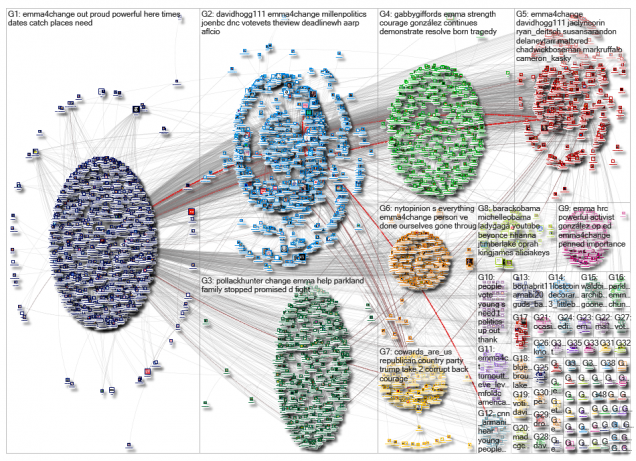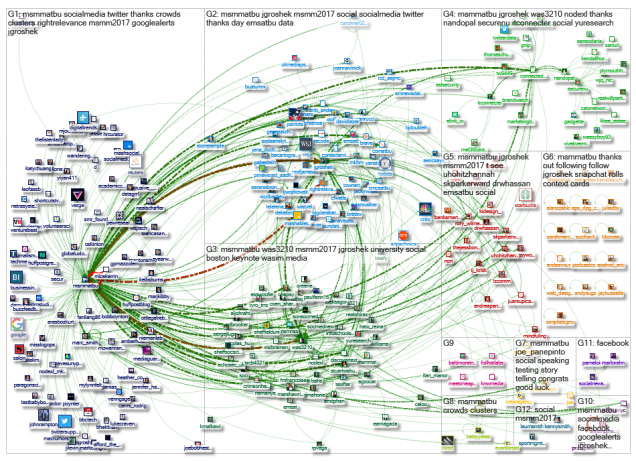Infomediation is defined as “the set of socio-technical mechanisms such as software, services, and infrastructure that provide internet users with all types of information online and connect them with users” (Smyrnaios, 2018). It is the way in which we access our information, which is being shaped more and more by oligopolies today.” This is because oligopolies are becoming extremely vertically integrated, meaning that “they control the market for four subsets and markets that are part of the infomediation infrastructure: operating systems, consumer electronics, telecommunications networks, and data centers” (Smyrnaios, 2018).
This raises the question: does infomediation and vertical integration shape network types?
To answer this question, we will look at two different topic networks, all centered around a specific topic mentioned on Twitter. Although there are 6 different types of network structures: fragmented, clustered, and inward and outward hub and spoke structures, (Smith, Rainie, Shneiderman, & Himelboim, 2014), we will only be looking at two, in order to see how information can be disseminated and shared. These structures are made up of people who are “replying and mentioning one another via tweets.”
The first graph is an example of a community (clustered) network and includes tweets from 5,108 users whose tweets contain “Emma4Change”(Smith et. al, 2014). To contextualize this, Emma is a survivor of the parkland shooting in Florida and social activist fighting for gun control and other social rights.

As seen in the graph, there are many different clusters that discuss their own smaller subset of topics, but are interconnected in that they all relate to one bigger theme; “Emma4Change.” When taking a closer look at the hashtags used in each group, there are a few overlaps, but for the most part, they differ. In Group 1, 2 and 3, the top hashtags were #marchforourlives, #vote, and #msm respectively (Emma4Change). Clearly, they all focus on different topics while being a subset of the broader theme of social change. A similar phenomenon is observed in the URLs discussed within each group. The top URLs in Group 1, 2 and 3 are a New York times article opinion article written by Emma (https://www.nytimes.com/2018/10/05/opinion/sunday/emma-gonzalez-parkland.html), a youtube video related to Donald Trump (https://www.youtube.com/watch?v=LuxqyEQE_cw&feature=youtu.be) and a tweet by Emma (https://twitter.com/Emma4Change/status/1047600887240282113) promoting an event for change, respectively (Emma4Change). A separation between each group is clearly seen as the themes discussed are different across them, however, the grey nodes between each group show their interconnectivity and the sharing of content that occurs between each group in form of retweets, or comments. This is a great example of the use of Twitter to reach a wider audience. As Rainie and Wellman discuss, more and more people are not only becoming networked individuals, but also network creators (Rainie & Wellman, 2014). Here, Emma Gonzalez acts as a network creator, using Twitter to promote social change and create a conversation. This resulted in these different groups which are all focused on their own topic of conversation within the bigger realm of social change.
The second graph is an example of a Broadcast (In-Hub and Spoke) Network (Smith et. al, 2014). This graph “represents a network of 268 Twitter users who tweets in the requested range contained “MSMMatBU”, or who were replied to or mentioned in those tweets” (MSMMatBU).

As seen in the picture, Group 1 appears to be the dominant hub, with nodes coming from the account “MSMMatBU.” All the other groups represent those who are sharing the dominant hub’s messages or who are talking about this topic based off of the bigger hub. When looking at the hashtag and word use within these groups, one can see a very apparent overlap, which is one of the characteristics of broadcast groups identified by Smith and his colleagues. Every group’s discussion includes most if not all the following hashtags #socialmedia, #twitter, #msmm2017. Additionally, the top word for every single group is msmmatbu, and the top 3 groups include the words “social media” and “jgroshek” (Emma4Change). This shows dissemination of information when “many people repeat what prominent news and media organizations tweet” (Rainie & Wellman, 2014). In this case, the media organization would be @MSMMatBU.
These examples of network types show the different ways in which topics can be discussed within a network. Infomediation and vertical integration are what have given us the ability to share content online, with anyone in the world, however we please. As Smyrnaios puts it “This vertical integration gives the oligopolistic players a privilege position enabling them to dominate the online services segment and the software segment in direct contact with internet users” (Smyrnaios, 2018). So, it is true that those who control our networks, the clouds, our operating systems, and our data are the oligopolies who are becoming increasingly vertically integrated. However, I believe what specifically affects network types is not the vertical integration of oligopolies and the power they hold over our user-generated contribution, but rather the type of content being discussed, and the opinions held on said content. When opinions or topics discussed differ, separate groups, are created with different amounts and kinds of interconnectivity between them. Another factor that affects network types are the kinds of users who choose to post and share information as well as the affordances of each platform, and what they allow us to share, in how many words. In this specific example, we are looking at Twitter, a platform that limits users to share information in under 140 characters which turn the platform into a place for quick distribution of information. This is seen in the two example network types discussed above, as they both demonstrate a discussion on specific events or topics that need awareness building. In one, the conversation is centered around the contributor “Emma4Change” who is an account with more 1.6 million followers, which is reflected in the abundance of users included in the conversation. Contrastingly, “MSMMatBU” has just under 4,000 followers, reflected in the less dense groups formed. However, they are both network creators and have both shared content which has started conversations. In this way, these accounts and those who interacted with their posts dictated the network types, while the oligopolies simply gave them the network and platform to share on.
Citations
Emma4Change_2018-10-07_15-01-34.xlsx. (n.d.). Retrieved from https://nodexlgraphgallery.org/Pages/Graph.aspx?graphID=170647
MSMMatBU_2017-12-15_07-28-00.xlsx. (n.d.). Retrieved from https://nodexlgraphgallery.org/Pages/Graph.aspx?graphID=132597#headerTopHashtags
Rainie, L., & Wellman, B. (2014). Networked: The new social operating system. Cambridge, MA: MIT Press. Smith, M. A., Rainie, L., Shneiderman, B., & Himelboim, I. (2014, February 21). Mapping
Twitter Topic Networks: From Polarized Crowds to Community Clusters | Pew Research Center. Retrieved from http://www.pewinternet.org/2014/02/20/mapping-twitter-topic-networks-from-polarized-crowds-to-community-clusters/
Smyrnaios, N. (2018). INTERNET OLIGOPOLY: The corporate takeover of our digital world. Bingley: Emerald Group Publ.